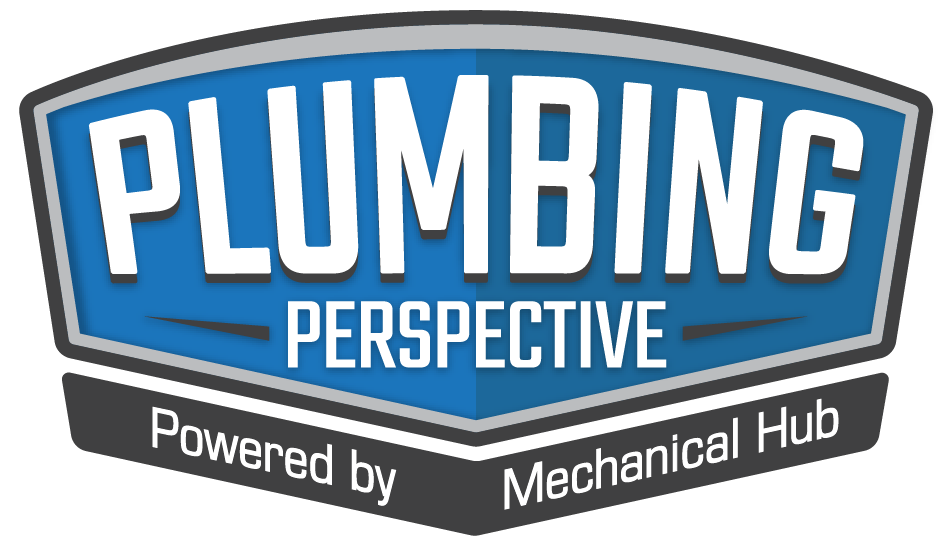The Plumbing-Heating-Cooling Contractors–National Association (PHCC) welcomed PHCC members, chapter executives, and corporate partners to Washington, D.C., May 16-17, to meet with lawmakers and educate them on energy, economic, and workforce policies that are important to the industry and consumers. Before heading to Capitol Hill as industry experts, members first heard from political expert Charlie Cook, who was the keynote speaker Read more
Plumbing

The Plumbing-Heating-Cooling Contractors–National Association (PHCC) welcomed PHCC members, chapter executives, and corporate partners to Washington, D.C., May 16-17, to meet with lawmakers and educate them on energy, economic, and workforce policies that are important to the industry and consumers.
Before heading to Capitol Hill as industry experts, members first heard from political expert Charlie Cook, who was the keynote speaker for the event. Cook spoke on the current political landscape, lessons from the 2022 midterms, and predictions for 2024.

After hearing from Cook, the group was briefed by PHCC Legislative Affairs Director Mark Valentini, PHCC Vice President of Regulatory Affairs Chuck White, and a panel of other industry lobbyists. Panelists included Jim Collura, vice president and director of government affairs for the National Energy & Fuels Institute (NEFI); Steve Rossi, vice president of advocacy for the American Supply Association (ASA); and Robert Wolfer, manager of government relations for Bradford White Corp (PHCC Strategic Partner). That evening, the group attended a reception in the historic Caucus Room of the Cannon House Office Building. This reception was held in conjunction with the Heating Air-conditioning and Refrigeration Distributors International (HARDI) and the Air-conditioning, Heating and Refrigeration Institute (AHRI). Members of Congress stopped by to network with members of PHCC and these other industry groups.
The next morning during breakfast, attendees heard insights from a second Washington Insider panel consisting of Craig Brightup, chief executive officer of the Brightup Group LLC; Matt Kiessling, senior director of state affairs for the American Gas Association (AGA); and Christopher Lindsay, vice president of government relations for the International Association of Plumbing and Mechanical Officials (IAPMO – PHCC Supporting Sponsor). After a quick stop for a picture on the Capitol steps, they headed to their respective meetings. In total, 71 PHCC members from 27 different states had 111 meetings with elected officials and their staffs. At a closing roof-top reception that evening, members spoke in-depth about how much they valued the in-person meetings on Capitol Hill, in addition to getting to participate in the rest of the sessions as a part of this two-day event.
“The 2023 PHCC Legislative Conference was an extremely valuable event for all who attended,” said PHCC—National Association President Dave Frame. “Besides the very beneficial one-on-one meetings with legislators, the conference was a great opportunity for PHCC members to connect with each other and with others in the industry supply chain. Together, we are able to accomplish so much more on behalf of our members, the industry, and society.”
The conference was sponsored by PHCC Corporate Partner Federated Insurance. Next year’s event will be May 21-22, 2024.
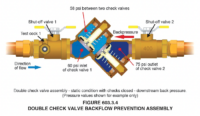
From the 2021 UPC Illustrated Training Manual, Chapter 6, WATER SUPPLY AND DISTRIBUTION 603.3.4 Double Check Valve Backflow Prevention Assembly (DC). A double check valve backflow prevention assembly consists of two independently acting internally loaded check valves, four properly located test cocks, and two isolation valves. The double check valve backflow prevention assembly (DC) is Read more
From the 2021 UPC Illustrated Training Manual, Chapter 6, WATER SUPPLY AND DISTRIBUTION
603.3.4 Double Check Valve Backflow Prevention Assembly (DC). A double check valve backflow prevention assembly consists of two independently acting internally loaded check valves, four properly located test cocks, and two isolation valves.
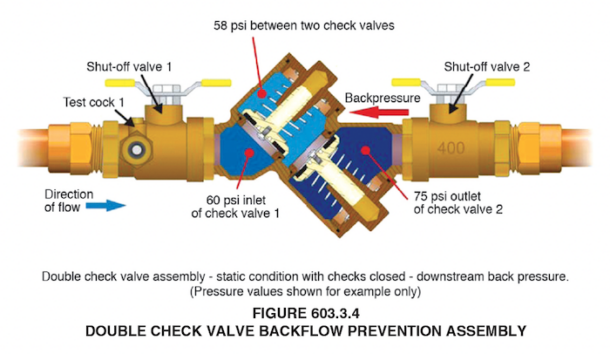
The double check valve backflow prevention assembly (DC) is just what it says – two check valves in series to prevent backflow (see Figure 603.3.4). The first check will close in a backflow condition. Usually one psi of backflow pressure will close the check. The second check is incorporated as a backup if the first check fails; however, there is no way to know if the second check has failed until it is tested. If the device fails, there is no means for removal of the polluted or contaminated water, which may then travel into the potable line. Therefore, the DC may only be used on low-hazard applications. Any liquid connected to the piping downstream of a DC should be a pollutant and not a contaminant.
The DC provides backpressure and backsiphonage protection. A DC may be used as meter-service protection as a containment, or on individual fixtures and appliances as isolation protection. A field test is required on installation, at least annually thereafter, after any repair and when relocated. The device must be installed a minimum of 12 inches above the surrounding ground or floor.
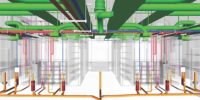
The designs of the plumbing system and the architectural design must work well together. Reduced installation costs are a direct result of good design. It could result in a more effective plumbing system and perhaps prevent future frequent plumbing problems. An architect who takes the plumbing system into account might even foresee future requirements, reducing Read more
The designs of the plumbing system and the architectural design must work well together. Reduced installation costs are a direct result of good design. It could result in a more effective plumbing system and perhaps prevent future frequent plumbing problems. An architect who takes the plumbing system into account might even foresee future requirements, reducing disturbances during upgrades and remodels. What advice should plumbers follow while creating plumbing systems, then? It is clear that architects are not plumbers. However, during the design process, architects need to take into consideration the plumbing.
Well, in order to help you find answers to that question, we have gathered the necessary information to provide you with those answers. Now, if you are ready and want to learn more, sit tight and let’s dive right into the topic at hand.
Learn About Plumbing Regulations
Plumbing requires careful consideration and detailed design, which should complement the building’s architectural features.
As an architect, it is your responsibility to ensure that your design complies with all applicable local, national, and international plumbing requirements.
For instance, certain codes may specify the number of units that must be connected to a particular fixture. Other construction regulations involve topics including pipe diameter, stormwater treatment, ventilation, and drainage.
Following these guidelines will help your design stand out from those of other creators.
Make sure you are informed on the most recent local building regulations for safety, water and energy conservation, as well as environmental effects.
Most local building authorities need pre-approval of draft plans before any plumbing work may start. If a thorough planning process is implemented, there will be no inconsistencies or errors in the drawings. Due to that, if you are working as a real estate agent, getting familiar with plumbing regulations is simply a necessity if you want to be one of the best architects Miami has to offer.
Consult with MEP Designers to Help
You can benefit substantially from the design expertise of mechanical, electrical, and plumbing engineers. In this manner, you may identify any issues that may arise throughout the installation and maintenance process. You probably already know that the clash between architectural and plumbing designs is one of the most significant worries of MEP designers and plumbers.
The greater your pre-design collaboration with them, the fewer issues will develop. In order to avoid any problems, try to work with a reputable plumbing business.
This strategy has the benefit of ensuring accurate plumbing sizing. Making enough area for plumbing fittings is another crucial problem in construction that can be avoided with enough research and cooperation from plumbing experts. This is where using BIM software may be quite helpful.
Take Energy and Cost into Consideration
Skilled architects should consider energy conservation when creating their designs. Some might wonder what connection there is between architects and energy.
For instance, it’s crucial to consider the distance between the water heater and the kitchen and bathroom. In reality, more heat will be lost the longer it takes the hot water to reach the user. These circumstances require the use of extra materials in addition to energy, which can get very expensive for the owners.
Another aspect that needs to be considered is the type of HVAC system and determine whether the inside layout of your home is effective for circulating air and allowing for natural ventilation. In actuality, you may minimize the requirement for mechanical ventilation with proper indoor architecture. Therefore, a key factor in lowering the building’s energy use is the architect.
Let Your Creativity Help You Along the Way
While each part of your plumbing system has a distinct function, they may also be employed as ornamental elements. Even though modern systems are frequently concealed in walls, some of their parts are still seen negatively. Sometimes these observable pipelines or other things can perform wonders. You may turn them into attractive items with a little imagination and even less money.
For instance, some interior designers think of hanging plant-filled vases to improve the aesthetics and air quality of the space. Others attempt to hide the pipes with wooden decorations to give the space a more traditional appearance. Although some individuals who have creative views are also interested in these designs, this is more appropriate for rural houses and cottages.
Final Thoughts
Although it is not the responsibility of architects to design plumbing systems, it is crucial that they understand the fundamentals of these systems. When designing bathrooms, kitchens, and other areas with plumbing fixtures, specific rules must be taken into account. If you refuse to take into consideration these regulations, it is needless to say that you will be met with quite a few problems in your line of work. Making an effort to learn and understand these regulations is a fundamental aspect that will help you succeed in your future jobs.
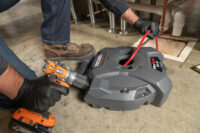
RIDGID®, part of Emerson’s professional tools portfolio, introduces the K9-12 FlexShaft® Drain Cleaning Machine, the latest in a complete line of RIDGID FlexShafts that provide wall-to-wall pipe cleaning power with astonishing speed. The K9-12 is the smallest of the machines and perfect for residential use, eliminating the need to repeatedly unclog the same household drain Read more
RIDGID®, part of Emerson’s professional tools portfolio, introduces the K9-12 FlexShaft® Drain Cleaning Machine, the latest in a complete line of RIDGID FlexShafts that provide wall-to-wall pipe cleaning power with astonishing speed. The K9-12 is the smallest of the machines and perfect for residential use, eliminating the need to repeatedly unclog the same household drain lines.
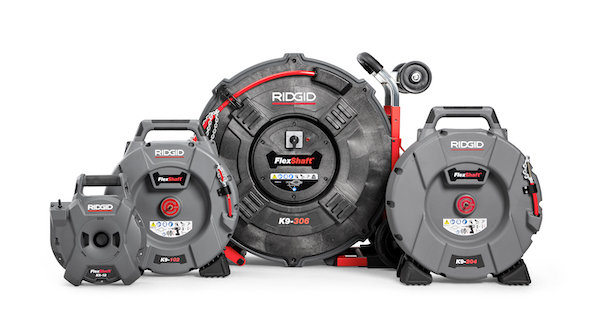
Clearing up to 30 feet of 1¼-to 2-inch pipe, the K9-12 breaks up grease, hair and other soft blockages, making it ideal for kitchen and bath sinks, as well as tubs and shower drains. Powered by an 1800 to 2500RPM cordless drill, the machine’s chain knocker expands inside the pipe to quickly clear the blockage andrestore the pipe to full flow. A flexible, protective sheath encapsulates the cable, keeping it fully enclosed for less mess and faster cleanup. The built-in clutch design also extends the cable life.
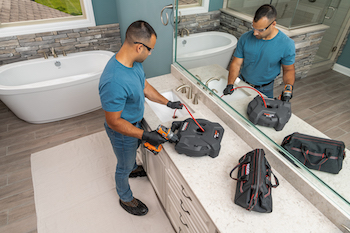 “Our K9-12 FlexShaft Drain Cleaning Machine is a great tool to start with if you have never experienced the cleaning speed and efficacy of a RIDGID FlexShaft Drain Cleaning machine,”said Shelby Gerl, product manager, RIDGID for Emerson. “It will save you time in removing common residential blockages and add value to your work by providing a fully flowing pipe again.”
“Our K9-12 FlexShaft Drain Cleaning Machine is a great tool to start with if you have never experienced the cleaning speed and efficacy of a RIDGID FlexShaft Drain Cleaning machine,”said Shelby Gerl, product manager, RIDGID for Emerson. “It will save you time in removing common residential blockages and add value to your work by providing a fully flowing pipe again.”
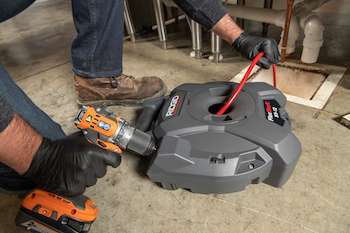 The K9-12 joins three additional RIDGID FlexShaft Drain Cleaning Machines–the K9-306, K9-204 and K9-104. Each provides wall-to-wall clean with astonishing speed. Designed for commercial use, the K9-306clears 3-to 6-inch diameter lines up to 125 feet; the K9-204 clears 2-to 4-inch diameter lines up to 75 feet;and the K9-1021¼-to 2-inch diameter lines up to 50 feet.
The K9-12 joins three additional RIDGID FlexShaft Drain Cleaning Machines–the K9-306, K9-204 and K9-104. Each provides wall-to-wall clean with astonishing speed. Designed for commercial use, the K9-306clears 3-to 6-inch diameter lines up to 125 feet; the K9-204 clears 2-to 4-inch diameter lines up to 75 feet;and the K9-1021¼-to 2-inch diameter lines up to 50 feet.
FlexShaft machines are backed by the RIDGID Full Lifetime Warranty.
To purchase or learn more about theK9-12 and entire line of FlexShaft Drain Cleaning Machines, visit RIDGID.com.

Over the past few years—wink, wink COVID—the industry has seen a rise in purchasing activity between plumbing and HVAC companies and private equity firms and other outside influences—coming in and gobbling up already successful contracting shops with a message of making them better. Sure, it’s a smart exit strategy as well for those looking to Read more
Over the past few years—wink, wink COVID—the industry has seen a rise in purchasing activity between plumbing and HVAC companies and private equity firms and other outside influences—coming in and gobbling up already successful contracting shops with a message of making them better. Sure, it’s a smart exit strategy as well for those looking to hang up the wrenches.
But why the flurry of activity now? “What we’ve seen from COVID is that the trades are pandemic-proof and to some extent recession proof. When money gets tight, consumers may hold off on that new car, going out to eat, but when that water heater goes out, it’s a necessity,” says Dan Foley, Foley Mechanical, Lorton, Va.
Foley continues, “Artificial Intelligence (AI) will never be able to take over this industry. You will always need someone to walk into someone’s home and make a repair, and that’s not easy to do. It’s the technician’s skill that AI cannot replace.”
According to Mike Prencavage Jr., president/owner, The Family Plumber, Los Alamitos, Calif., president, PHCC ORSB, director, PHCC National Business Development, “Working on margins is crucial for any business to succeed; however, in the plumbing industry most companies aren’t struggling with tight margins to turn a profit.”
As an example, Prencavage Jr. says restaurants and bars can stand to lose greatly if more than two ounces of alcohol is poured into any drink or if larger than accounted for portions of food are served on any plate. These private equity firms have seen that plumbing companies have a greater amount of sold labor income per invoice that can offset losses on jobs allowing for much wider margins to run a profitable business.
“Private equity firms are also looking to the future of renewable energy. With the electrification of the nation soon to be at every state’s doorstep, government grant funding has already become available to plumbing companies who are leading the way by installing energy efficient products. These grant programs. combined with the opportunity to capitalize on wider margins, are creating a buzz of interest from private equity groups to get more involved in the plumbing industry sector,” says Prencavage Jr.

Speaking of grants, on a national level, the Infrastructure Bill and Inflation Reduction Act, are ripe for the taking, if eligible.
On the flipside, private equity firms offer contractors security, not only monetarily, but though the expansion of their reach and service offerings across their respective regions, expand evolving customer bases and refine overall strategic growth initiatives.
Just last month, Grove Mountain Partners—a private equity firm investing in lower, middle market home service companies and specialty business service companies—announced the sale of Unique Indoor Comfort Holdings LLC to Ace Hardware. Nate Kukla, CEO, and the entire management team, including the brand presidents, will continue to lead the company as it embarks on its next growth phase.
Grove Mountain brought together 12 independent service-providing businesses, beginning in June 2021, with the acquisition of three related companies: Moncrief Heating & Air, Unique Indoor Comfort of Philadelphia, and Werley Heating & Air. It added nine other companies in the Eastern region of the U.S., including Clay’s Climate Control, Detmer & Sons, Canella Heating & Air, A-Total Plumbing, All Phase Electrical, Dick Hill & Son, Carolina Custom, Rye Heating and Air, and Jackson Plumbing and Heating & Air.
“We are grateful for our partnership with Grove Mountain and are proud of what we have built and accomplished,” said Nate Kukla, CEO. “Now, we are excited to be part of the Ace team which will allow us to leverage their combined financial and operational capabilities and expertise. Since day one, Unique has been passionately dedicated to an employee-centric, high-integrity, and customer-focused culture. Ace shares in our mission and values and brings a plethora of resources to allow us to continue and grow the business.”
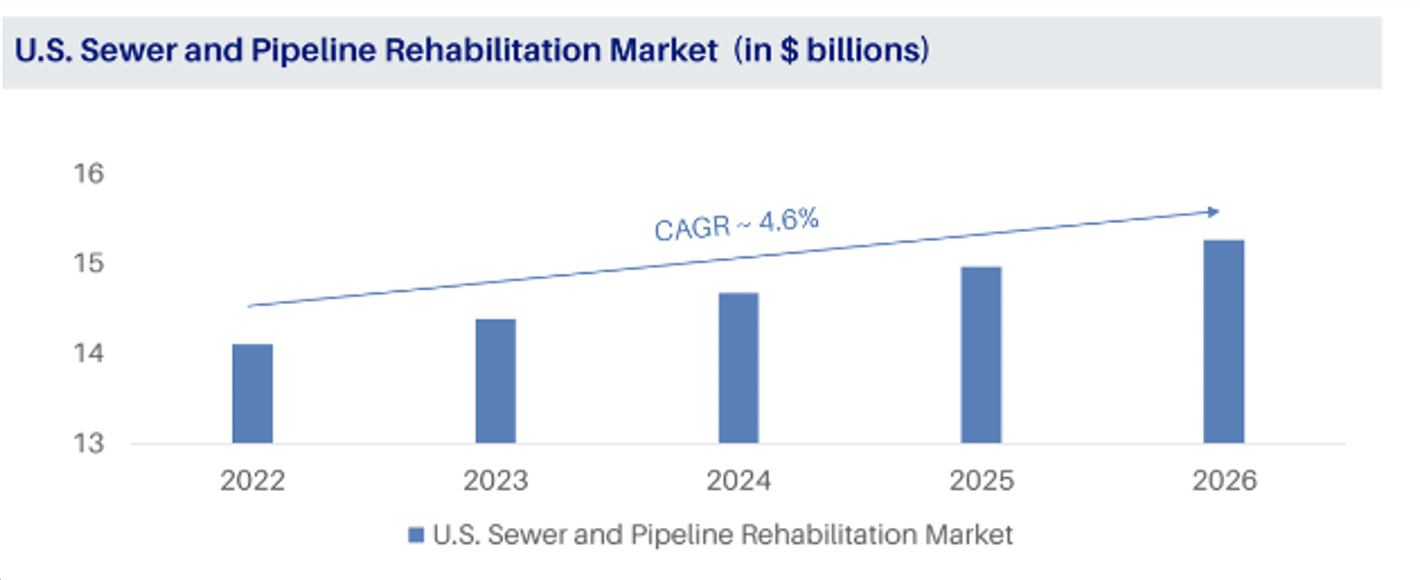 Also, this month, Auctus Capital Partners—a leading financial services and investment banking firm focused exclusively on creating value for the lower middle market, which specialize in merger and acquisition advisory, institutional private placements of debt and equity, financial restructuring, valuation, and strategic consulting—announced its role as exclusive advisor to The Precision Group and its affiliated entities, supporting the environmental and infrastructure services leader in completing a majority recapitalization by PowerVac, a Pillsman Partners LLC and Peninsula Capital Partners, LLC portfolio company.
Also, this month, Auctus Capital Partners—a leading financial services and investment banking firm focused exclusively on creating value for the lower middle market, which specialize in merger and acquisition advisory, institutional private placements of debt and equity, financial restructuring, valuation, and strategic consulting—announced its role as exclusive advisor to The Precision Group and its affiliated entities, supporting the environmental and infrastructure services leader in completing a majority recapitalization by PowerVac, a Pillsman Partners LLC and Peninsula Capital Partners, LLC portfolio company.
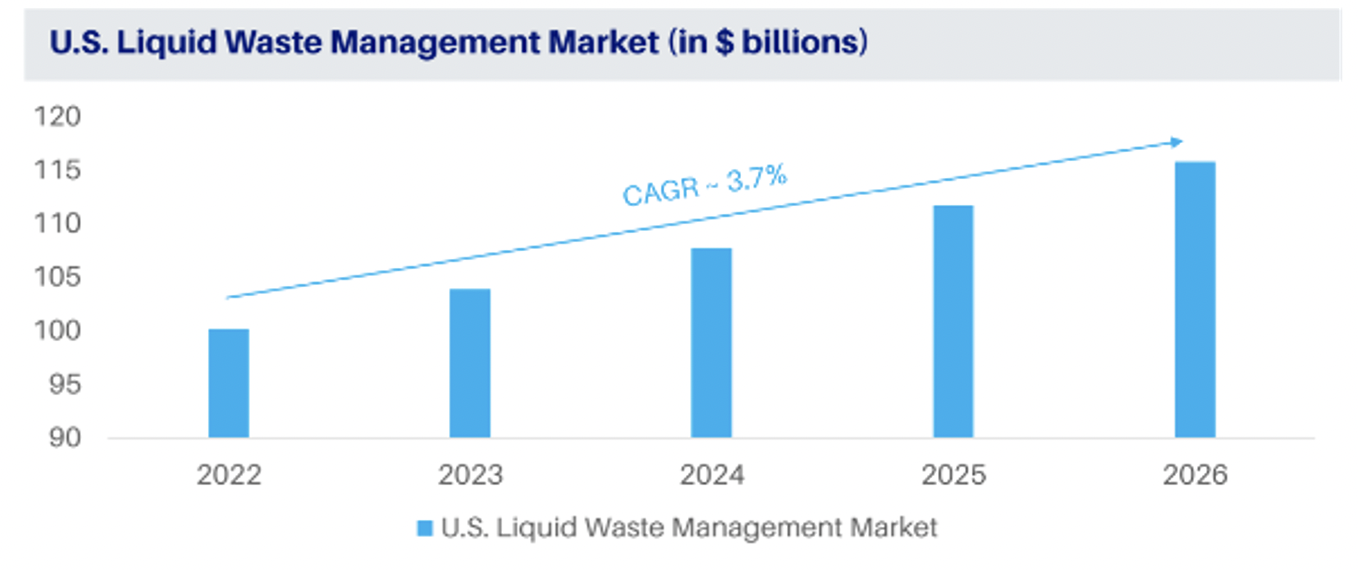 The Precision Group is comprised of three separate yet complementary companies that serve a diverse array of commercial, industrial, and municipal customers. Founded in 1992, Precision Industrial Maintenance, Inc. provides environmental remediation, industrial cleaning services, hazardous and non-hazardous waste transport and disposal, and other industrial waste services. Martin Environmental Services, Inc. was acquired by Precision Group in 2002, adding new services in asbestos and lead abatement, and disposal services. Precision Trenchless, LLC was formed in 2013 to focus on environmentally-friendly pipe rehabilitation using less disruptive technologies, such as UV-Cured and other Cured-in-Place Pipe Lining (CIPP) methods, potable water line rehab to minimize air, water and soil pollution and support advanced monitoring services.
The Precision Group is comprised of three separate yet complementary companies that serve a diverse array of commercial, industrial, and municipal customers. Founded in 1992, Precision Industrial Maintenance, Inc. provides environmental remediation, industrial cleaning services, hazardous and non-hazardous waste transport and disposal, and other industrial waste services. Martin Environmental Services, Inc. was acquired by Precision Group in 2002, adding new services in asbestos and lead abatement, and disposal services. Precision Trenchless, LLC was formed in 2013 to focus on environmentally-friendly pipe rehabilitation using less disruptive technologies, such as UV-Cured and other Cured-in-Place Pipe Lining (CIPP) methods, potable water line rehab to minimize air, water and soil pollution and support advanced monitoring services.
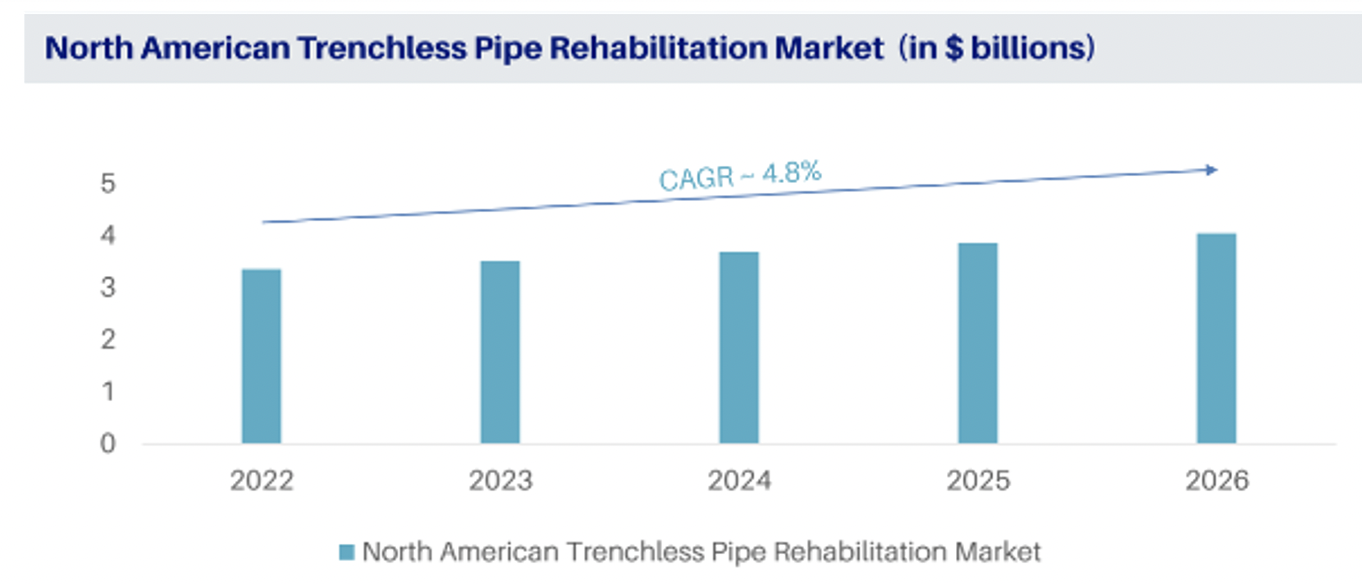 The group of companies operate as a unified provider of services to several broad regional markets with strong projected growth through 2026 — including the sewer and pipeline rehabilitation market with a compound annual growth rate (CAGR) of 4.6%, as well as trenchless pipe rehabilitation (4.8% CAGR), and liquid waste management (3.7% CAGR).
The group of companies operate as a unified provider of services to several broad regional markets with strong projected growth through 2026 — including the sewer and pipeline rehabilitation market with a compound annual growth rate (CAGR) of 4.6%, as well as trenchless pipe rehabilitation (4.8% CAGR), and liquid waste management (3.7% CAGR).
“Underpinned by significant government support for the repair of aging infrastructure, pipeline rehabilitation and wastewater management services are seeing record investment. In addition, an ever-growing awareness of ESG issues has been driving strong investor demand,” says Muhammed Azfar, CEO and managing partner, Auctus.
More to come on this topic.
